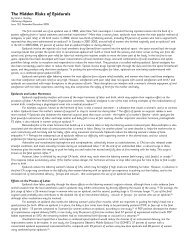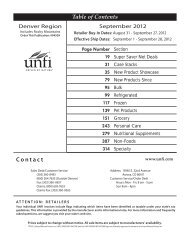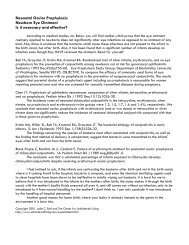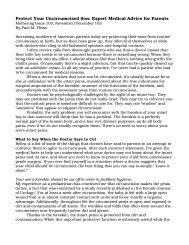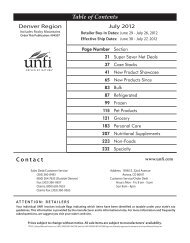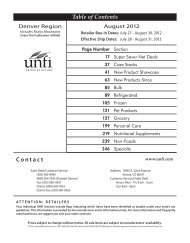Nipple shields
Nipple shields
Nipple shields
You also want an ePaper? Increase the reach of your titles
YUMPU automatically turns print PDFs into web optimized ePapers that Google loves.
sample copy sample copy sample copy<br />
Applying the shield<br />
There are differences of opinion about how best to apply a<br />
nipple shield. Here are a few suggestions.<br />
Place the shield over your breast, with your nipple<br />
centered inside the tip. Press your fingers along the edge<br />
of the brim to keep it in place.<br />
Place the shield on your breast with the soft brim turned<br />
out away from the breast, then smooth the brim onto<br />
your breast.<br />
Turn the tip halfway inside out and place it over your<br />
nipple. Then slowly ease the shield fully right side out<br />
and onto the nipple.<br />
Dip the shield in hot or warm water before putting it on<br />
or apply a small bit of Lansinoh Brand Lanolin for<br />
Breastfeeding Mothers ® to help it cling to your skin.<br />
Milk supply concerns<br />
When use of a nipple shield starts, mothers should<br />
monitor their supply of milk and their babies’ weight gain<br />
carefully. In the first few days, it is helpful to pump after<br />
feedings. Milk gathered in this way can be used as a<br />
supplement if one is needed. Mothers of babies who are<br />
premature or have neurological disorders may have been<br />
pumping before starting to use a nipple shield.<br />
After nursing, look for milk in the tip of the shield and<br />
check for a decrease in breast firmness. Your baby’s health<br />
care provider may suggest periodic weight checks to make<br />
sure your baby is getting enough milk. You can also<br />
monitor the adequacy of your milk supply by keeping<br />
track of the number of your baby’s wet and dirty diapers.<br />
If your baby needs a supplement, you can use a nursing<br />
supplementer along with a nipple shield. A supplementer<br />
encourages some babies to suckle well, because swallowing<br />
helps trigger more effective suckling. Pay close attention to<br />
your baby’s position at the breast as you begin using a<br />
supplementer to be sure he is sucking actively and taking<br />
enough of your breast into his mouth. Some babies learn<br />
to suck the supplement from the supplementer without<br />
breastfeeding effectively.<br />
Weaning from a shield<br />
diapers he has to be sure he is getting as much milk<br />
without the shield as he was with the shield.<br />
You may encourage your baby to breastfeed without the<br />
nipple shield by providing more skin-to-skin contact in<br />
between feedings. At feeding times, let him nurse with the<br />
shield until his initial hunger is eased and then try to<br />
remove the shield and offer your bare breast. Use your<br />
knowledge of your baby’s likes and dislikes to discover a<br />
way that works for you. Be patient. Babies stop using<br />
nipple <strong>shields</strong> when they don’t need them any more.<br />
The decisions you make about using a nipple shield will be<br />
as individual as you are. If your baby is having trouble<br />
learning to breastfeed, you will especially appreciate the<br />
company of other mothers interested in breastfeeding. You<br />
can meet other breastfeeding mothers at local La Leche<br />
League meetings. To find a La Leche League Group near<br />
you, look in your local phone book, call LLLI at 800-LA<br />
LECHE or 847-519-7730, or check on our Web site at<br />
www.lalecheleague.org/WebIndex.html<br />
Resources<br />
Bodley, V. and Powers, D. Long-term nipple shield use–A positive perspective.<br />
J Hum Lact 1996; 12:301-04.<br />
Brigham, M. Mothers’ reports of the outcome of nipple shield use. J Hum<br />
Lact 1996; 12:291-97.<br />
Clum, D. and Primomo, J. Use of a silicone nipple shield with premature<br />
infants. J Hum Lact 1996; 12(4):287-90.<br />
Elliot, C. Using a silicone nipple shield to assist a baby to latch. J Hum Lact<br />
1996; 12:309-13.<br />
Meier, P. <strong>Nipple</strong> <strong>shields</strong> for perterm infants: effect of milk transfer and<br />
duration of breastfeeding. J Hum Lact 2000; 16(2): 106-14.<br />
Mohrbacher, N. and Stock, J. The Breastfeeding Answer Book.<br />
Schaumburg, IL: LLLI, 2003.<br />
Sealy, C. N. Rethinking the use of nipple <strong>shields</strong>. J Hum Lact 1996; 12:299-<br />
300.<br />
The Womanly Art of Breastfeeding. Schaumburg, IL: LLLI, 1997.<br />
Wilson-Clay, B. Clinical use of silicone nipple <strong>shields</strong>. J Hum Lact 1996;<br />
12(4):279-85.<br />
Woodworth, M. and Frank, E. Transitioning to the breast at six weeks: use of<br />
a nipple shield. J Hum Lact 1996; 12:305-07.<br />
For breastfeeding support, to order our publications, or to<br />
find an LLL Leader near you, use our Web site at:<br />
www.lalecheleague.org<br />
Or phone: 800 LA LECHE (9-5 Central Time)<br />
847-519-7730 (24-hour messages)<br />
Follow your baby’s cues in discontinuing use of the nipple<br />
shield. A baby may use a nipple shield for a few days or a<br />
few months. Premature babies who use nipple <strong>shields</strong> are<br />
often observed to stop needing to use them around the<br />
time of their original due dates.<br />
During the time your baby is weaning from a nipple<br />
shield, keep a close watch on how many wet and dirty<br />
© 2003 La Leche League International



